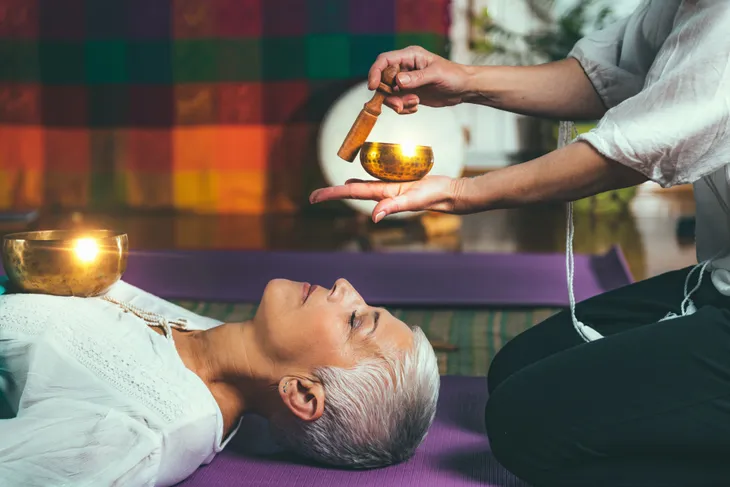In recent years, sound bathing, a therapy in which sound is used for healing, has been marketed as one of many “self-care” practices, such as journal-keeping or candle-burning, in support of personal well-being. Sold also as sound “immersions,” or sound “healing” or “therapy,” sound baths are pitched as a safe and effective way to reduce stress and increase inner peace.
Do they, though? If so, how? As a medical anthropologist who has conducted research on the sound bath boom, I have some evidence-based insights to offer.
What is a sound bath?
Dedicated yogic sound baths are typically intimate, hourlong, small group events hosted in yoga studios or other private settings. Lights dimmed, perhaps with essential oils diffusing, providers surround their typically recumbent clients with sound generated from simple instruments such as tuning forks, gongs and bowls. In my research, sound bath receivers and providers say this leads to a deep sense of peace or harmony.
Some people claim erroneously that what we call sound baths are an ancient practice. There is a long-standing tradition in yoga of using sound to focus one’s meditative efforts, perhaps most famously in chanting “Aum.”
But sound baths emerged in their present form largely as an outgrowth of the rise of modern yoga – the kind that focuses on postures, or “asanas.” These classes generally include, at the end, a short, meditative, “rest and receive” phase, or “savasana.” A yogic sound bath is, essentially, a sound-enhanced, extended, savasana-only sound immersion session.
The commodification of yogic practices in the West, along with celebrity endorsements, have resulted in the modern-day sound bath industry. Many yoga studios now offer sound baths regularly: It “draws people in,” explained one owner.
Early research and health benefits
There is evidence that shows that yogic sound therapy can bring benefits. Data confirms associations between yoga practice and better physical and mental health.
Regarding sound baths specifically, in a study involving the controlled exposure of 62 people to singing bowls, gongs, cymbals called ting-shas, and other simple instruments, subjects reported decreased tension, anger and fatigue. A review including several other somewhat smaller studies found that sound immersion can also improve blood pressure, heart rate, respiratory rate and other clinical indicators.
Scientific understanding of the mechanics of sound therapy is in its infancy. But preliminary studies have shown that a well-executed sound bath may help reduce anxiety and even improve blood pressure and heart rate, among other clinical outcomes.
In my research, many participants pointed to science in explaining why sound baths worked so well for them, referencing for instance the nervous system’s capacity to move us into a “rest and digest,” or relaxation, state. Many also referenced spiritualized concepts, such as the “chakras,” seven wheel-like energy or spiritual power centers running up the spine, which they believe the vibrations can “unblock.”
Navigating options
The sound bath experience varies. For instance, some are held outside. Some providers play lots of different instruments, not just simple percussive ones or singing bowls. Some bring in lots of yogic philosophy; others leave that unspoken. Some infuse sessions with what I call “trauma talk,” inviting clients to focus on inner pain; others remain silent regarding client motivations for participating.
With sound baths so widely available, no regulations, and a wellness market hungry for profit, how do you choose what kind to attend? Here are some guidelines, based on my study.
To begin, participants said that the ideal sound bath site enables clients to let down their guard. This may mean locking studio doors or providing warm blankets and cushioning so that receivers can comfortably relax into the soundscape offered.
Outdoor sound baths can be nice, but concern about onlookers, noise intrusions and imperfect weather could undermine a sense of sanctuary. The same was true for baths conducted in noisy fitness centers or other locations not built to promote inner peace.
Practitioner style also mattered. Interviewees recommended backing out if a provider makes you uncomfortable, because relaxation will be difficult. They also noted that providers with less experience often play too loudly, make jarring versus gentle transitions and forget to pause. Relatedly, baths with lots of diverse or complex instruments, or songs that tell a story, make maintaining meditation difficult.
Yet another distraction came from providers focused on suffering, stress or trauma. Observations confirmed that too much “trauma talk” might prime clients to focus on and even amplify any sense of distress, diverting them from the simple pleasure of an immersion and from their own resilience.
Even the best sound bath cannot relieve stress long term if the causes of that stress remain in place. Nevertheless, in a world where inner peace is hard to find, let alone maintain, an hour spent in meditative repose can be a godsend.
Elisa J. Sobo, Professor of Anthropology & Director for Undergraduate Research, College of Arts and Letters, San Diego State University
![]()
This article is republished from The Conversation under a Creative Commons license. Read the original article.






